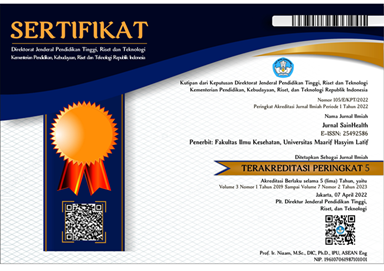AKTIVITAS PROBIOTIK BAKTERI Enterococcus lactis SA8 ASAL SUSU KERBAU SUMBAWA (Bubalus bubalis)
PROBIOTIC ACTIVITY OF Enterococcus lactis SA8 BACTERIA FROM SUMBAWA BUFFALO MILK (Bubalus bubalis)
DOI:
https://doi.org/10.51804/jsh.v8i2.16905.70-75Keywords:
Enterococcus lactis SA8, Probiotics, lactic acid bacteria, pH and bile salt testsAbstract
The most important quality of lactic acid bacteria as probiotics used for additives is tolerance to bile salts and low pH, which allows bacteria to survive, grow, and provide therapeutic effects in the digestive tract. Probiotics are living microorganisms that can provide optimal health effects when consumed in certain amounts, even exceeding general nutrition. Lactic acid bacteria are probiotic bacteria that can provide good health benefits when consumed regularly. The growth and production of lactic acid in LAB are influenced by pH and bile salts, this ability distinguishes between species of lactic acid bacteria. LAB must have The main physiological requirements of probiotic bacteria are their resistance and tolerance to low pH and bile salts. This study aims to test E. lactis SA8 bacteria from Sumbawa Buffalo milk to determine their probiotic activity through tests on pH resistance and their ability to live in bile salts. E. lactis SA8 bacteria have probiotic activity, which is indicated by their ability to withstand low pH, and the results of bile salt testing show the highest viability at a concentration of 0.3% with a density of 9.8x107 CFU/mL, which is a sign of probiotic bacteria.
Keywords: Probiotics, lactic acid bacteria, Enterococcus lactis SA8, pH and bile salt tests
References
Agestiawan, I.G.A.M., Swastini, D.A., Ramona, Y., 2014. Uji Ketahanan Bakteri Asam Laktat yang Diisolasi dari Kimchi Terhadap pH Rendah 22–27. https://doi.org/10.5205/jurnal.farmasiudayana.3.2.22-27
Asnita, D., Meryandini, A., 2018. Bakteri Asam Laktat Kandidat Probiotik dari Susu Kuda Bima. Sumberd. Hayati 9, 49–54. https://doi.org/10.29244/jsdh.9.2.49-54
Bawole, K. V., Umboh, S.D., Tallei, T.E., 2018. Uji Ketahanan Bakteri Asam Laktat Hasil Fermentasi Kubis Merah ( Brassica oleracea L.) Pada pH 3. J. MIPA 7, 20. https://doi.org/10.35799/jm.7.2.2018.20624
Dowdell, P., Chankhamhaengdecha, S., Panbangred, W., Janvilisri, T., Aroonnual, A., 2020. Probiotic Activity of Enterococcus faecium and Lactococcus lactis Isolated from Thai Fermented Sausages and Their Protective Effect Against Clostridium difficile. Probiotics Antimicrob. Proteins 12, 641–648. https://doi.org/10.1007/s12602-019-09536-7
Fahmi, A., Syukur, S., Chaidir, Z., Melia, S., 2023. Isolation and molecular characterization of probiotic from Sidamanik green tea (Camellia sinensis) fermentation. Biodiversitas 24, 4277–4288. https://doi.org/10.13057/biodiv/d240809
Febrina, N.N.T., Bahri, S., Rasmi, D.A.C., 2019. Susu Segar Kambing Etawa Yang Difermentasi Dalam Bambu Betung (Dendrocalamus Asper) Dan Bambu Tali (Gigantochloa Apus) Sebagai Probiotik Bakteri Asam Laktat. J. Pijar Mipa 14, 89–94. https://doi.org/10.29303/jpm.v14i1.1054
Felix, Chandra, R., Fachrial, E., 2024. Potensi Probiotik Isolat Dnh 16 Dalam Menurunkan Kadar Kolesterol Secara in Vitro. J. Kesehat. Masy. 8, 101–112. https://doi.org/10.31004/prepotif.v8i1.21342
Gajjar, P., Patel, P., Rathod, Z., Patel, B. V, 2019. Isolation , Characterization and Identification of Probiotic Bacteria From Fruits and Vegetables 11–23.
Harmoko, D., Ardyati, T., Jatmiko, Y.D., 2022. Isolation and Screening of Lactic Acid Bacteria From Sumbawa Buffalo Milk (Bubalus bubalis) as Potential Starter Cultures. J. Exp. Life Sci. 12, 88–97.
Ibrahim, S.A., Yeboah, P.J., Ayivi, R.D., Eddin, A.S., Wijemanna, N.D., Paidari, S., Bakhshayesh, R. V., 2023. A review and comparative perspective on health benefits of probiotic and fermented foods. Int. J. Food Sci. Technol. 58, 4948–4964. https://doi.org/10.1111/ijfs.16619
Okfrianti, Y., Darwis, D., Pravita, A., 2018. Bakteri Asam Laktat Lactobacillus Plantarum C410LI dan Lactobacillus Rossiae LS6 yang Diisolasi dari Lemea Rejang terhadap Suhu, pH dan Garam Empedu Berpotensi sebagai Prebiotik. J. Ilmu dan Teknol. Kesehat. 6, 49–58. https://doi.org/10.32668/jitek.v6i1.108
Pangestu, A.D., Kurniawan, K., Supriyadi, S., 2021. Pengaruh Variasi Suhu dan Lama Penyimpanan terhadap Viabilitas Bakteri Asam Laktat (BAL) dan Nilai pH Yoghurt. Borneo J. Med. Lab. Technol. 3, 231–236. https://doi.org/10.33084/bjmlt.v3i2.2169
Przerwa, F., Kukowka, A., Kotrych, K., Uzar, I., 2021. Probiotics in the treatment of gastrointestinal diseases. Herba Polonica. https://doi.org/10.2478/hepo-2021-0012
Rahmiati, Simanjuntak, H.A., 2019. Kemampuan Bakteri Asam Laktat dalam Menghambat Salmonella thypii. J. Jeumpa 6, 257–264. https://doi.org/10.34007/jns.v1i3.25
Silaban, B.J.S., Nurhayati, L., Hartanti, A.W., 2020. Viabilitas Probiotik Lactobacillus acidophilus DLBSD102 Setelah Mikroenkapsulasi. J. Sains Nat. 10, 6. https://doi.org/10.31938/jsn.v10i1.266
Suryani, E.M., Gaffar, A., 2024. Isolasi Dan Karakterisasi Bakteri Asam Laktat Dari Susu Kuda Bima (Equus sp.) Yang Berpotensi Sebagai Probiotik. J. Ilm. Biosaintropis 9, 102–108. https://doi.org/10.33474/e-jbst.v9i2.561
Tawab, F.I.A., Abd Elkadr, M.H., Sultan, A.M., Hamed, E.O., El-Zayat, A.S., Ahmed, M.N., 2023. Probiotic potentials of lactic acid bacteria isolated from Egyptian fermented food. Sci. Rep. 13, 1–16. https://doi.org/10.1038/s41598-023-43752-0
Utami, F., 2013. Pengaruh Suhu Terhadap Daya Tahan Hidup Bakteri pada Sediaan Probiotik, Repository UINHJ.
Utami, L.S., Syukur, S., Jamsari, 2019. Isolasi bakteri probiotik penghasil protease dan laktase dari fermentasi kakao varietas hijau. Chem. Prog 5, 109–114. https://doi.org/10.35799/cp.5.2.2012.775
Widigdo, B., Yuhana, M., Iswantari, A., Madonsa, C., Sapitri, I.D., Wardiatno, Y., Hakim, A.A., Nazar, F., 2021. The impact of nitrifying probiotic to population growth of pathogenic bacteria, Vibrio sp., and toxic nitrogen gasses in marine shrimp culture media under laboratory condition. J. Pengelolaan Sumberd. Alam dan Lingkung. 11, 130–140. https://doi.org/10.29244/jpsl.11.1.130-140
Downloads
Published
Issue
Section
License
Copyright (c) 2024 Jurnal SainHealth

This work is licensed under a Creative Commons Attribution 4.0 International License.
Jurnal SainHealth is licensed under Creative Commons Attribution 4.0 International License.
Under the following terms:
Attribution — You must give appropriate credit, provide a link to the license, and indicate if changes were made. You may do so in any reasonable manner, but not in any way that suggests the licensor endorses you or your use.
No additional restrictions — You may not apply legal terms or technological measures that legally restrict others from doing anything the license permits.
















